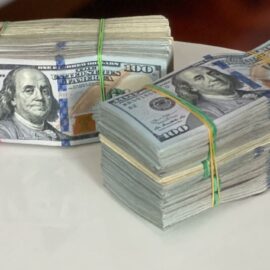

This article is an excerpt from the Shortform summary of "The Smartest Guys in the Room" by Bethany McLean and Peter Elkind. Shortform has the world's best summaries of books you should be reading.
Like this article? Sign up for a free trial here .
What was the Enron collapse, and how did it happen?
The Enron collapse of 2001 occurred when Enron, a company that had previously been wildly successful in the stock market, declared bankruptcy. The Enron collapse was due to a combination of unethical accounting practices, the failure of business watchdogs, and other factors. Keep reading to find out about the issues that contributed to the Enron collapse.
The Enron Collapse
The failure of Enron in the early 2000’s is one of the largest bankruptcies in US history (with Lehman Brothers in 2008 as the largest). Its accounting scandal led to Enron’s bankruptcy as well as the dissolution of Arthur Andersen, one of the big five accounting firms. Shareholders were wiped out, and tens of thousands of employees left with worthless retirement accounts due to the collapse of Enron. But why did Enron fail?
Today the name “Enron” still evokes a reflexive repulsion, a feeling that these were simply bad people doing illegal things. But, we think, that’s in the past. Surely we’ve evolved as a society, and by thinking hard enough, you or I can avoid these problems.
In reality, when you dig into the details, Enron’s downfall is the predictable mixture of human greed, poorly structured incentives, and lack of sanity checks when everyone has their fingers in the pie.
You might be surprised to learn that most of Enron’s accounting tactics were not technically illegal at the time – they were actually publicly celebrated for being financial innovations. Shareholders, employees, investment bankers, and accountants all benefited from the situation and enabled Enron for years. They only stopped when it became untenable. This is a big part of the question “Why did Enron fail?”
The most important takeaway from The Smartest Guys in the Room is to understand the key enabling conditions for Enron’s deception. When multiple conditions mutually reinforce each other and create positive feedback loops, a massively outsized result – a lollapalooza – can happen.
These are also the warning signs you can use to detect unstable situations and desist from bad behavior.
1. Accounting practices that disguised the fundamentals
The root of the Enron collapse has to be the accounting tactics that enabled deception. They let Enron book more revenue than they actually earned; keep losses and debt off balance sheets. If these were disallowed, the money-losing state of Enron would have been apparent far sooner.
- Mark-to-market accounting allowed booking the total value of a deal immediately, rather than spaced out over time.
- Complicated SPE deals allowed Enron to borrow money while keeping it off their balance sheet
- One-time asset sales were booked as recurring revenue
- Deals that were actually dead were fictitiously kept alive to avoid a writedown that quarter
All this structure became so convoluted that no one totaled up the big picture. No one pieced together the dependencies between Enron’s deals, and how the dominoes would fall if Enron’s stock price fell.
Lesson: Resist the temptation of clever accounting tricks that mislead on fundamentals, even if they’re technically legal. You may eventually deceive even yourself on the true fundamental strength of the situation.
Poorly constructed compensation structures that rewarded unprofitable behavior
A pattern of Enron’s compensation style was to reward short-term behaviors (like stock price or closing deal sizes) without concern for long-term value (like profitability). And according to the book’s author, Skilling happily fed greed, believing it was the best motivator for performance.
- Deal makers were given bonuses for the deal value when it closed, not on the generation of actual cashflow. With optimistic projections, deal makers got paid for bad unprofitable deals.
- Employees got bonuses for short-term stock prices, thus incenting bad behavior to prop up stock price.
- Senior managers like Skilling got large bonuses for stock performance. This prompted over-optimistic projections to Wall Street, which intensified the speed of rushing into bad businesses (Enron Broadband) and created end-of-quarter scrambles to make earnings.
Lesson: Make sure your compensation structures align with the fundamental goals of the business, and that there are balancing check points
2. Believable guiding visions
These party lines began with good intentions, but as Enron slipped into a gray zone, they helped justify bad behavior.
Enron saw itself as revitalizing an industry populated by dinosaurs and bringing efficiency through privatization and free markets. With a missionary
Andy Fastow’s department saw itself as a financial wizard, pushing the boundary of possibility while staying within the lines of GAAP accounting. They were just playing the rules of the game, which ultimately led to the collapse of Enron.
Stakeholders/watchdogs overlooking bad behavior as long as they were profiting
People who could have stepped in and intervened didn’t, often because they had a large personal stake in Enron’s success. Further, the more Enron became a success (like in terms of stock price or deal flow), the more beholden the stakeholders were to Enron.
- Shareholders (employees and the public in general) didn’t look very hard, as long as the stock price rose and employees got bonuses. Why stop the party?
- Enron’s accountants (Arthur Andersen) couldn’t lose Enron as a client (Enron kept accountants waiting in the wings), so they tolerated their practices despite internal skepticism. Furthermore, Enron gave many Andersen accountants cushy jobs.
- Investment bankers earned large fees from Enron’s complicated deals, even when they knew they were skirting the intent of the law. Bankers who ran bigger deals got promotions. They competed for Enron’s business.
- Buy-side analysts at banks who were supposed to be independent were strongly pressured to give buy ratings, since companies would only work with positive banks.
- Short sellers were a useful counterforce, since they had a large incentive to expose wrongdoing.
Lesson: Correct for your own incentive bias when you analyze a situation.
3. Looking to others believing they had done their due diligence
When you have multiple reputable people on board, everyone thinks everyone else has done their diligence. Surely all these other people can’t be wrong! In reality, no one has done their diligence.
- Employees thought the board and accountants would keep bad behavior in check, and thought public markets were heavily incented to detect bad behavior.
- The board trusted the internal risk department, which in reality was a yes-man and thought their only job was to sign off on deals.
Lesson: Don’t trust other people’s due diligence. Assume they have the worst possible incentives to overlook problems. Do your own due diligence from first principles.
4. Big bets on businesses that failed
According to the author, the accounting tricks were meant to be short-term bridges to the real new money-makers: Enron Energy Services (retail utilities) and Enron Broadband. When asking “why did Enron fail?” you have to consider the full picture.
Enron plowed a ton of money into these businesses, in typical Enron “move fast and go big or go home.” Their read of the market and industries was wrong.
Enron’s optimistic promises to Wall Street created a situation where Enron had to deliver fast on businesses, or else their stock price would plummet.
Lesson: Don’t excuse bad practices as temporary measures until your saving grace comes around.
5. Complex dependencies that required progressively bigger risks or face complete failure
Enron built layers of financial dependencies in a constant push to raise stock prices and led to the Enron collapse. In essence, it kicked the can down the road, hoping that salvation would come at some point.
- For example, Enron’s mark-to-market accounting might put the value of a 20-year deal down as recurring revenue in one quarter. Wall Street expected this to be real recurring revenue, which meant Enron had to book larger deals that had bad long-term prospects to keep up appearances.
Here was the nightmare scenario (that materialized):
- Enron’s stock price was high because of misleading accounting and overoptimistic projections.
- If Enron ever missed earnings, its stock price would fall.
- If its stock fell, its SPE deals would unwind (since they were predicated on Enron stock prices), causing Enron to have to book massive debt on its balance sheet or issue new shares. This would cause further stock price falls.
- This increased debt would cause a downgrade of Enron’s creditworthiness to junk status.
- This would trigger provisions in Enron’s debt agreements to pay back loans early, and trading partners to demand cash collateral.
- Since Enron didn’t actually have cash, its ability to pay would progressively worsen, causing trading partners to withdraw and further decrease revenue.
- This would cause bankruptcy.
Lesson: Don’t create scenarios where you kick accountability down the road and bet on a big salvation moment. Take moves to de-risk moment to moment, and take a big write down earlier. Be even more wary if this is an existential risk, since for the sake of staying alive you might take more desperate steps.
6. An unwillingness to consider the worst case scenario seriously
Because of such strong incentive bias, social proof, and self-consistency bias, Enron managers refused to believe that the stock price would ever fall and trigger the nightmare scenario.
Lesson: Seriously consider the worst case scenario, and think about ways that you can mitigate this.
7. Bad appointments to senior managers
The collapse of Enron was also fueled by bad leaders. Generally, promoting people who had the wrong kind of ambition (more to themselves than to the fundamental health of the company).
- Andy Fastow, known for experience creating financial structures rather than financial prudence, was promoted to CFO.
- Ken Lay was more interested in being a public figure than in managing the business.
- The board was weak, filled by Ken Lay with people who had reciprocal relationships with Enron.
Lesson: Hire people with the right kind of ambition, who want to grow the long-term success of the company (and are incented correctly).
8. Punishments for dissent/skepticism
Internally, Enron skeptics were punished for voicing discontent or blocking deals. They were reassigned to less glamorous parts of the company or publicly humiliated on their failure (like Rebecca Mark).
- Enron partners (accountants, bankers) who voiced discontent lost the deals. Enron managers even strongly encouraged the dismissal of employees who added friction to deals.
- Skilling had a tactic of making people feel dumb for asking questions. “All the data is out there. If you don’t get it, you’re just dumb.” Naturally, in the heady times of the dotcom boom, people didn’t want to look dumb or be wrong, in case Enron turned out to be a huge success.
Lesson: In your search for the truth, put aside the centering of your ego around being smart. If something seems too complicated for you to get, it’s probably not your fault – keep pressing.
The Enron collapse proved that big businesses could fail, and it was possible that no one would see it coming. Some claimed that the Enron collapse should have been a warning to the financial disaster of 2008.

———End of Preview———
Like what you just read? Read the rest of the world's best summary of Bethany McLean and Peter Elkind's "The Smartest Guys in the Room" at Shortform .
Here's what you'll find in our full The Smartest Guys in the Room summary :
- How Enron rose to become one of the world's most promising companies
- How Enron management's greed led it to start cutting corners
- The critical failures that crashed Enron's house of cards to the ground






